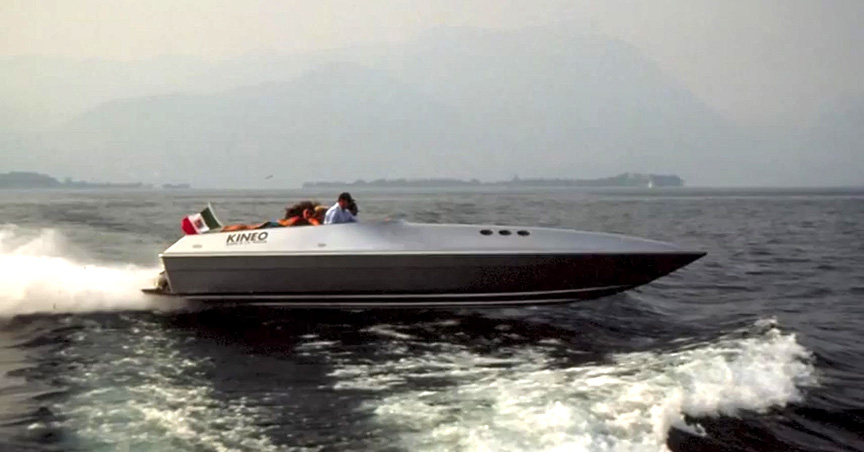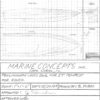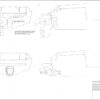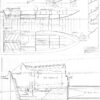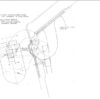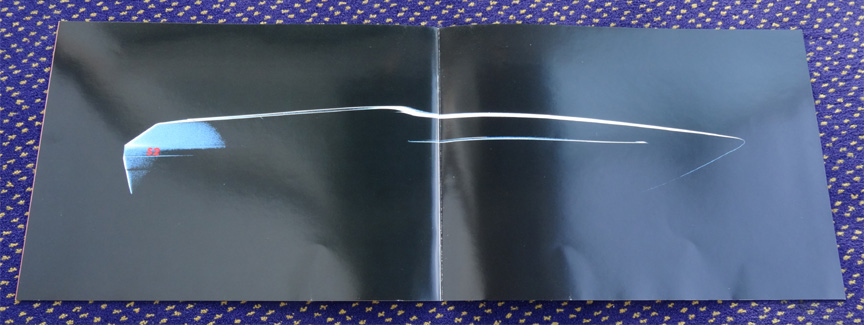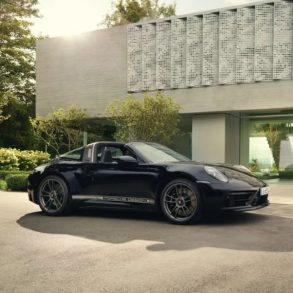Kineo 27 Porsche Design Speed Boat
1991-1993
When Dr. Horst Stross presented the first Kineo, the 46-foot version, at the 1986 Genova boat show, American Gerald (Jerry) Berton approached him at the show with an idea of a similarly designed, but smaller speed boat, maybe in the size of around 25 foot… The idea of the later Kineo 27 was born.
Although Stross liked big boats and had lost huge amount of money with the Kineo 46, he liked the smaller Kineo idea from the financial point of view. Jerry Berton became the leader of the project. He offered Stross that he would build the boat in Florida at the company he works, Tempest Yachts, and that he would also sell the boat throughout the USA. Tempest Yachts was a high-end marine company owned by Richard (Dick) Simon and naval engineer Adam Erdberg.
While the Kineo 46 was already planned to be fitted with marinised and turbocharged Porsche 928 S4 engines (were not fitted), such turbo engines were also planned for the Kineo 27. German company Wizeman Marine had introduced the marinised Wizeman-Porsche WP 928 S4 normally aspirated engines to the market in the end of 1986, but they at 320 hp lacked the power Stross and Berton were looking for, so the engines needed to be turbocharged. The target was to get 800 to 1000 hp in total from two Porsche V8 engines. The turbocharged 928 marine engine program was actually on the table at Porsche’s R&D center in Weissach as Jacky Ickx and Tullio Abbate had ordered such engines for their offshore racing boat.
Like with the Kineo 46, no efforts were spent on the hull design and an existing suitable sports hull was to be selected.
In 1950s Ray Hunt had invented the deep-V hull with longitudinal strakes on the bottom to give added lift and throw out the spray to keep the boat dry. In 1960s Don Aronow asked Jim Wynne and Walt Walters to design a high performance deep-vee hull for racing. The resulting ‘Aronow’ hull design was subsequently used for many boats – Formula, Donzi, Magnum 27 (1966-1968), Cigarette Signature 27 and for the Kineo 27.

The Aronow style hull design was kept, just another strake was added to the top edge of the hull. Porsche Design worked on the rest of the Kineo 27 between 1987 and 1988. The deck design shared its cues with the 1986 Kineo 46, but was even more sleeker, more dynamic. Like with the Kineo 46, the master of the design was Jörg Tragatschnig, who worked under head designer Dirk Schmauser in the design studio of Ferdinand Alexander Porsche in Zell am See, Austria.
Although turbocharging was still on the table for Kineo 27, the normally aspirated 928 engines were first installed into Tempest 32 as exhibited in February 1988 at the Miami boat show.
The design of the Kineo 27 was filed for a patent at the US Patent office on October 25, 1988.
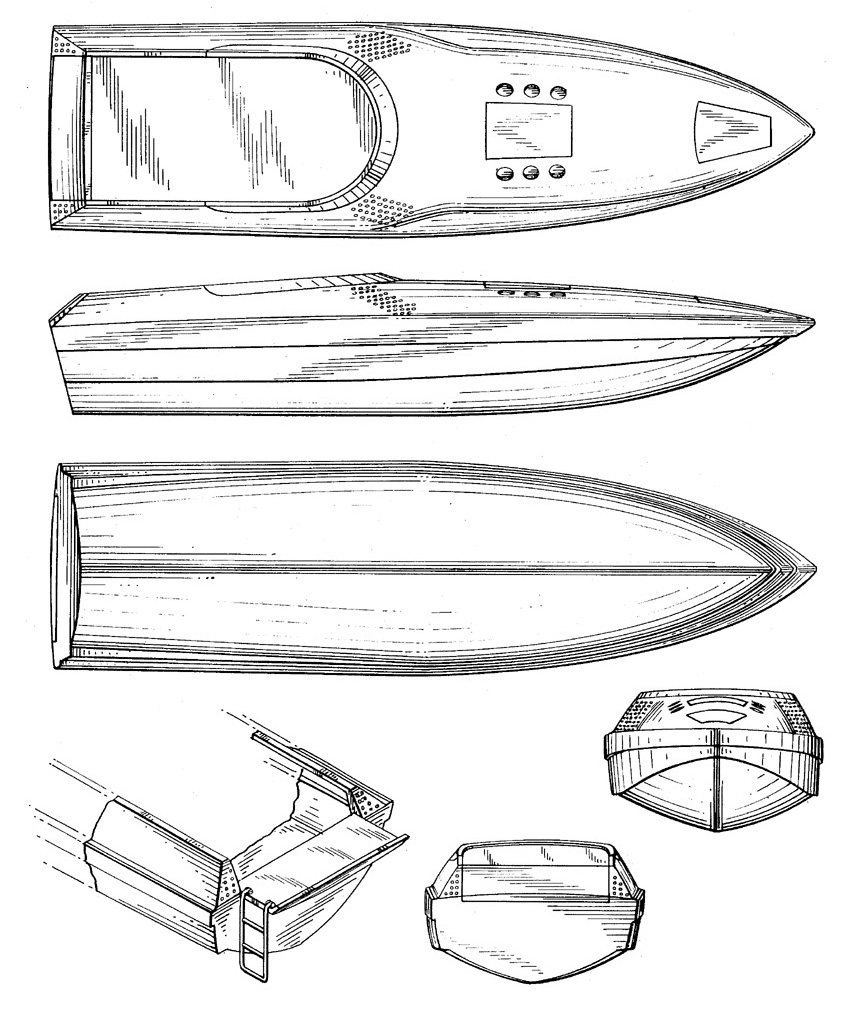
An ad in Motor Boating & Sailing magazine (USA) in January 1989 said: “…what really makes this boat Das Boot are two marine-modified Porsche 928 S4 turbo-charged engines with waterjet drives”.
The ad said the Kineo 27-foot boats would be available at Porsche dealers in USA in early 1989. The price for the Kineo 27 with two twin-turbo Porsche V8 and a Porsche Design Team trailer was announced at 100.000 USD. This was approximately the price of two 911 Carreras. Considering the two experimental twin-turbo V8, the boat price seemed very low. The announcement was too optimistic in terms of price and the date of market launch.
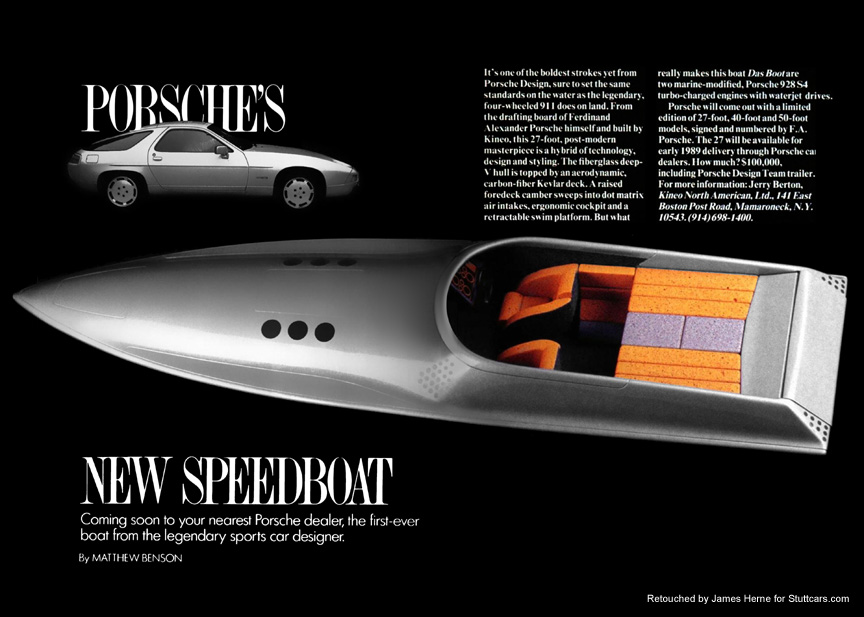
To sell the boats, Berton did something special – he signed a contract with Porsche in USA to sell the Porsche Design Kineo speed boats through official Porsche dealers. Then, he managed to sign contracts with 16 official Porsche dealers to sell the Kineos. The contract stipulated a dealer had to order a minimum of 5 Kineos. It sounded like 80 boats were already sold before the first one was made. As a sales tool for Porsche dealers, around 20 scale models in the size of 1:10 were produced.
Tempest Yachts was a boat builder, but they outsourced the prototyping and tooling. First, a company in Texas was hired, but it didn’t work out and Berton took the deep-V hull to naval engineer Augusto ‘Kiko’ Villalon’s company Marine Concepts Inc. in Cape Coral, Florida. Interestingly, there was no contract between Tempest Yachts and Marine Concepts, because Villalon was a man of words and didn’t like written contracts. Kiko Villalon was aghast of Porsche Design demandings. What he got was a concept drawing with detailed specifications. All deck hatches, cleats, and lights had to be disappeaing. Same with the swim platform that folded out of the transom with an invisible hinge, and the ladder aswell. No fasteners were to be visible inside or outside. And no seams were to be visible anywhere, so that the entire structure would appear smooth and singular. Marine Concepts started to work on the project in August 1989.
Marine Concepts Sketches
Member’s International magazine wrote in December 1989 that Tempest Yachts had just contracted to build Kineo powerboats. While Tempest concentrated on engineering and building the boats, a separate marketing and distribution arm was founded on December 22, 1989, called Global Yachts & Performance Boats Ltd. The sales and marketing manager was Jerry Berton.
The experimental turbocharged 928 marine engines didn’t find their way into the Kineos. Probably because there wasn’t enough room in the Kineo 27 and because Porsche was not interested in developing these experimental engines for every day use (engines for racing use were sold without warranty). So, the 800-1000 hp Kineo 27 dream had to be forgotten. The two normally aspirated 928 S4 engines provided 470 kW (630 hp/640 PS) in total. The recession started to set in and after new calculations, even a single 928 engine version was put on the drawing board. The top speed would drop from around 61 to 48 knots, but the range would extend even despite the smaller tank designed for the single engine version.
As the Kineo 27 was initially intended only for American market, it was designed with jet drives. When it was clear Stross wanted to present the Kineo 27 also in Europe, stern drive version had to be designed. The problem was the initially designed swimhatch hinges lowered the hatch too much and it would not work with the twin stern drive configuration.


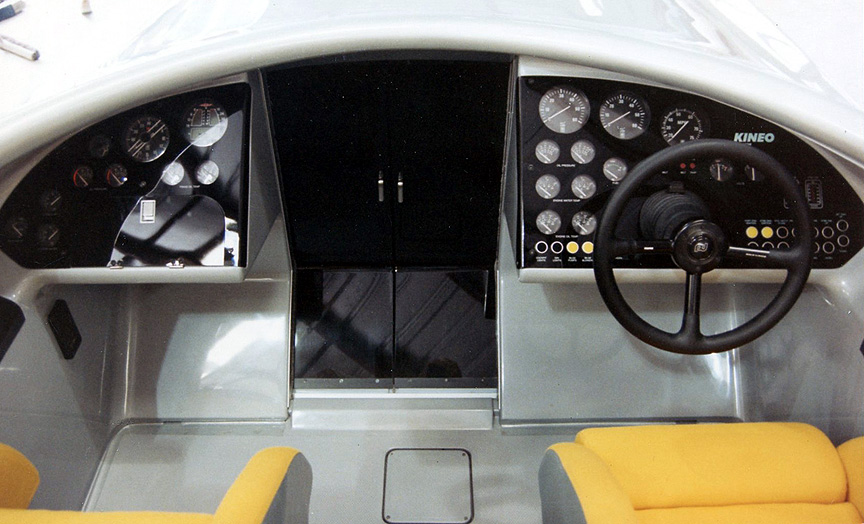



Because of demandings from Porsche Design, the Kineo was not easy to make. Kiko Villalon commented: “Even the liner couldn’t have any seams. We had to laminate it wth the deck, then take the mold apart inside… It was the most complicated tooling I’d ever done”. The hull (solid bottom, cored sides) and deck were hand laid and vacuumbagged, but other parts had to be injection-molded, and some, like the dash, made out of rubber. Villalon described the latter: “The boat did not have a windshield, that area was curved up slightly, suggesting a low screen, and here there was a U-shape, all the way around the front part of the cockpit, a sort of soft rubber bumper. Since the piece was 6.5′ (2 m) wide and some 6′ (1.8 m) long, the problems of casting this with soft polyurethane foam were many, and shrinkage was one of them. We estimated the shrinkage at 7/8″ (22 mm) and made the mold that much longer. Finally, it turned out to be a beautoful addition to the boat and one that had never been tried in the industry”. The first prototype was almost finished in March 1990.
The dashboard design did not conform to the one from Porsche Design and had to be changed for the next prototype.
While the first prototype was painted gray (non-metallic), the next prototype was already painted silver as was set by Porsche Design. Marine Concepts built three prototypes and then handed the tooling over to Tempest Yachts.
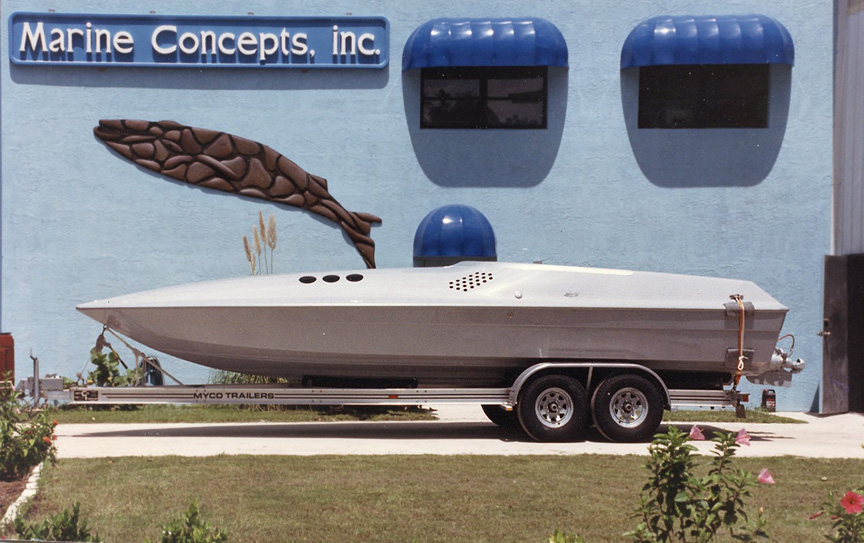
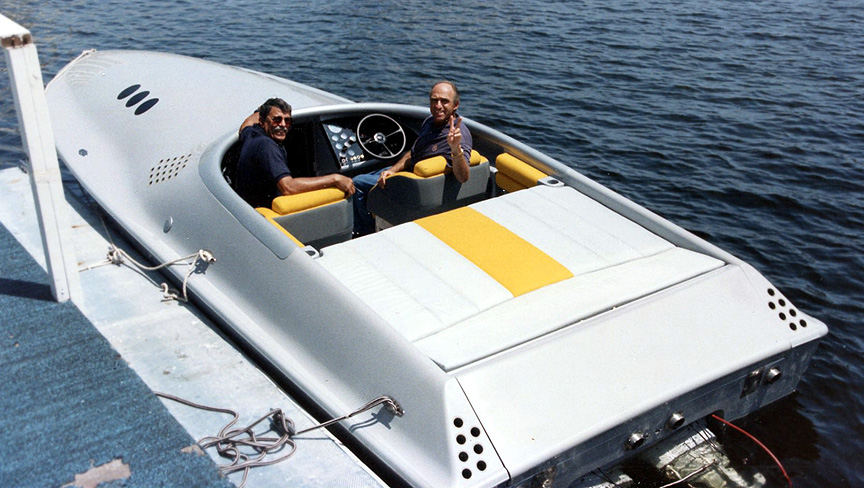

One of the Marine Concepts prototypes was sent to Europe. It was taken from Florida to New York and then flewn with Boeing 747 to Europe, to be displayed at the Boot ’91 Düsseldorf boat show in Germany from January 19, 1991. At the show the boat was called as Kineo 270 S2. “S2” was the new designation for the Kineo with two engines. By the way, at the same time Porsche had a model called 944 S2 in production.

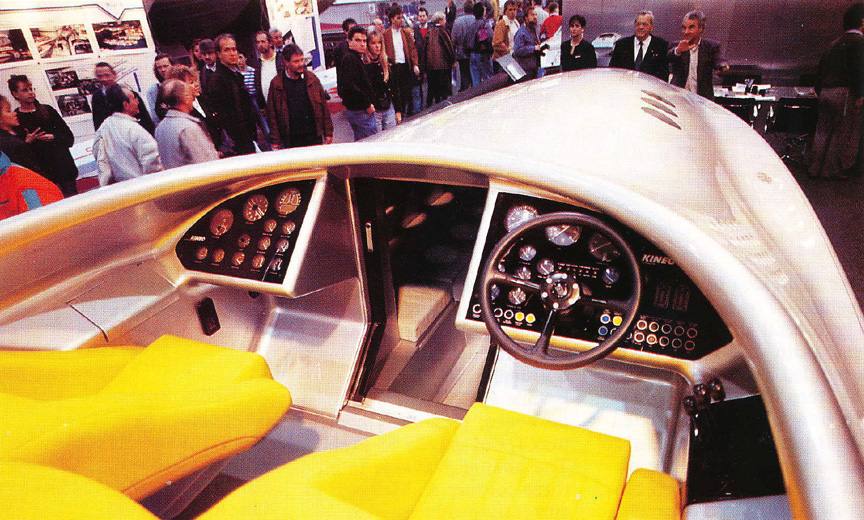
Wizeman Marine had discontinued the Porsche engine marinisation program in Germany and in the beginning of 1991, a special Kineo company for marinising the 928 engines was created in Zumikon, Switzerland. The Swiss Kineo company bought the know-how and tooling from Wizeman Marine. The company was officially registered a bit later, on April 19, 1991 and was called Kineo Sales and Engineering AG. The founders were Horst Stross and Frank M. Rinderknecht (well known for his company Rinspeed).
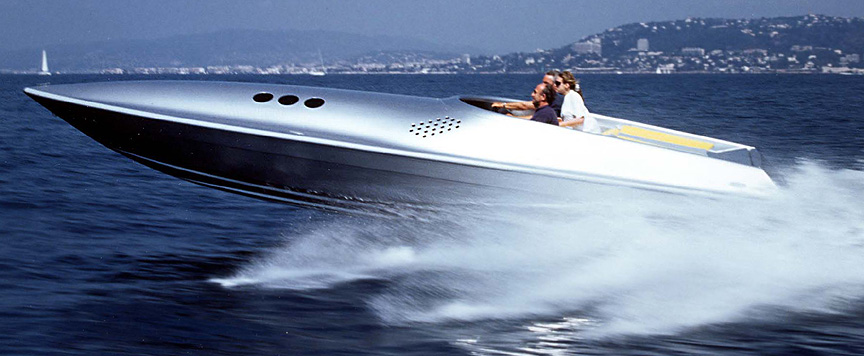
Another Kineo, this time a Tempest built boat with propellers (stern drives), was taken from Florida to Europe. The test and demonstration drives happened in the spring of 1991 in many places off the coast of the Mediterranean Sea between Monaco and Marseille, France, including Cap d’Antibes where Dr. Stross had his own villa (the birthplace of the idea of the earlier Kineo 46).

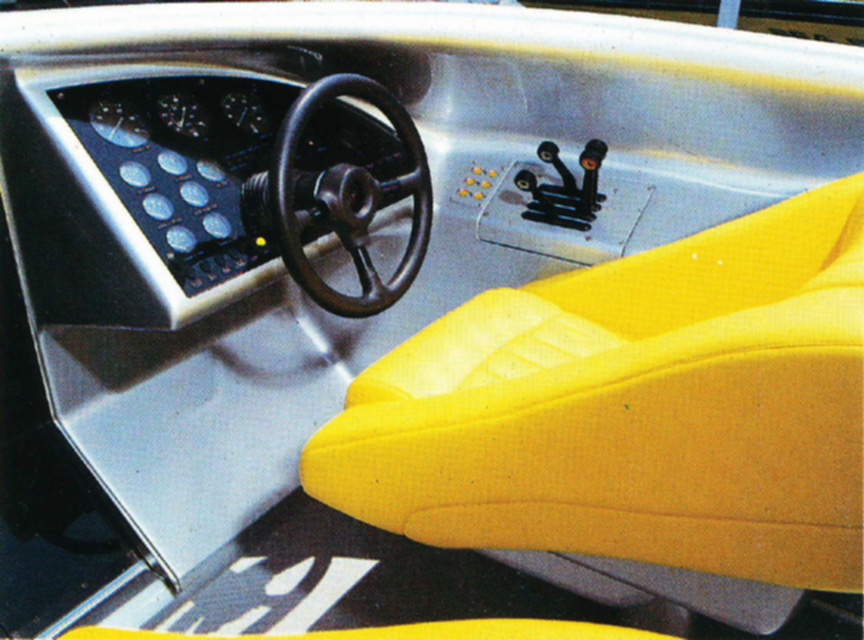
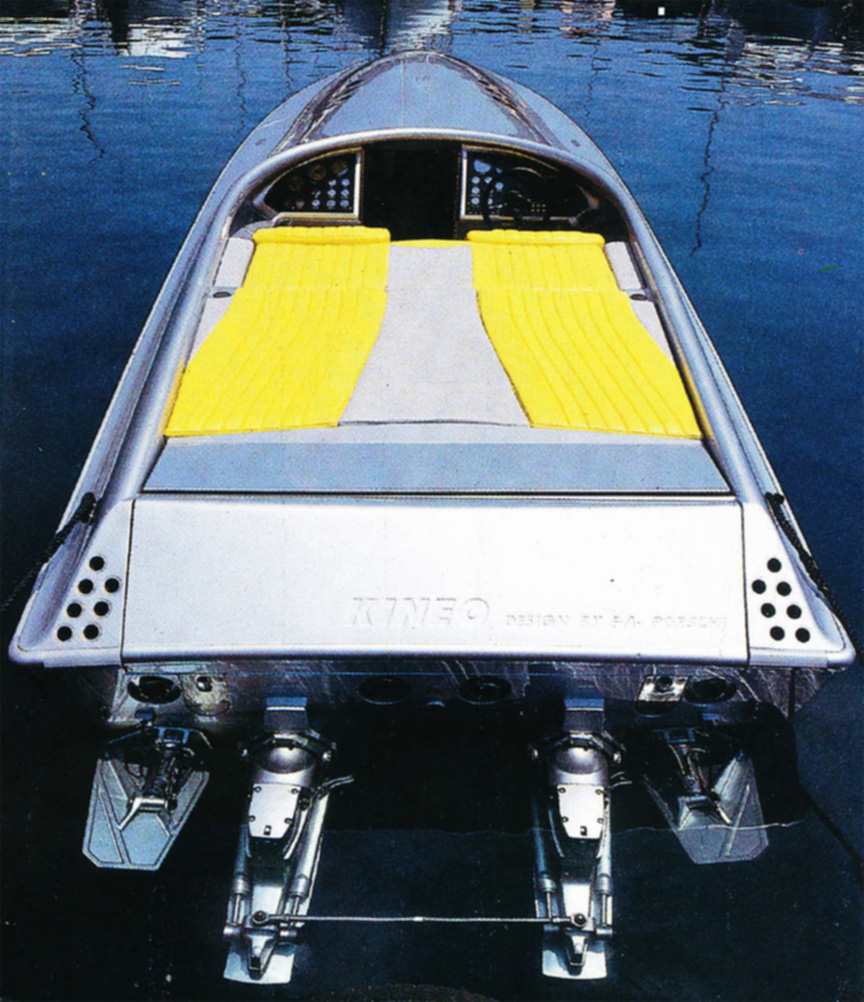
Stross told that he would also create a different Kineo for European market – a 12 meter (40-foot) version with the highest technology. He announced that it would be built in the high-end Tencara boatyard in Venice, Italy. This Kineo 40 would be ready by May 1992 and the plan was to make 12 a year (none were made).
Advertising from April 1991 told that the Kineo could also be ordered with single 928 engine. This was the first time a single engine version was mentioned publicly.
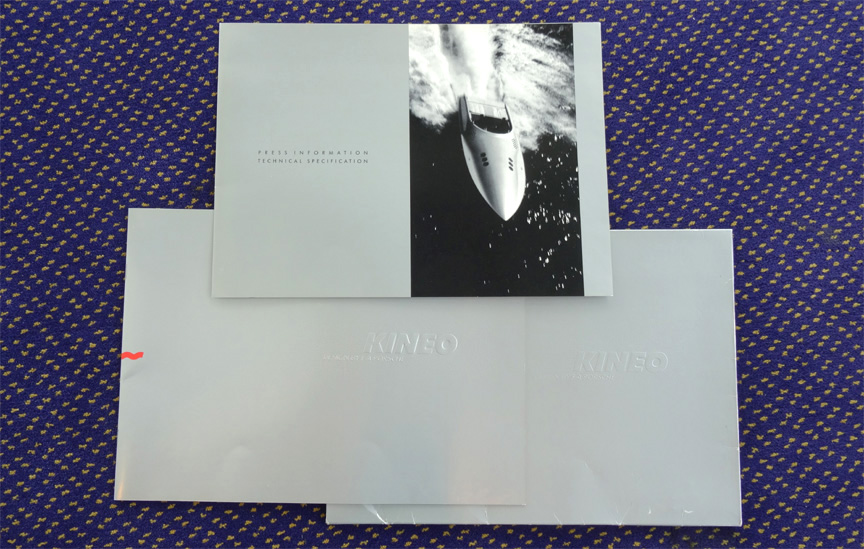
There were two contact addresses on the back of the 1991 European brochure: Kineo in Graz, Austria (home city of Horst Stross) and Kineo Sales and Engineering AG in Zumikon, Switzerland.
Jerry Berton planned to present the Kineo together with the Porsche Design trailer in USA from May 1991, but he had to cancel the Kineo project because of the economic recession that had started. Horst Stross was not ready to give up and the Kineo now had the hopes only on European market.
In Europe, one of the Kineos, probably the propeller version demoed in Antibes, was shown at Fondation Cartier art museum during the exhibition “La Vitesse” (“The Speed”) until August 1991. At that time Fondation Cartier was located in Jouy-en-Josas, just outside of Paris in France. The Kineo was part of the set-up created by artist Kristian Gavoille in the museum’s park.
The Kineo 270 S2 was also advertised in the Rinspeed press materials for IAA Frankfurt motor show in September 1991.
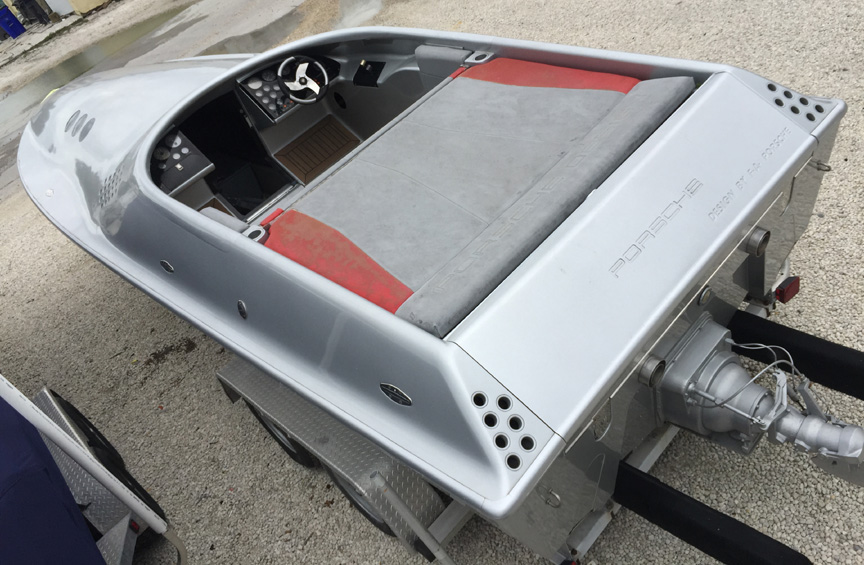
Although the Kineo business plan in USA was cancelled before summer of 1991, the ready made hulls and components were used to build the last boats in the second half of the year. These boats were single Porsche engine boats with jet drive. According to Berton, he had sold two Kineos to Japan. The total number of Tempest Yachts built Kineos is uncertain.
In Italy, one Kineo (probably the one shown in Antibes), was converted from twin 5.0-litre Porsche engines to single 7.4-litre MerCruiser for test purposes. The conversion was done by Stain, the company of Fausto Atzori, who also built the sole aluminium prototype of the Kineo 33 in 1991-1992.

As the production in USA didn’t work out, Horst Stross talked again to many boat builders. After Austrian Kineo 46, American Kineo 27 and Italian Kineo 33 projects (and the 40 and 50 ft being engineered as he mentioned!), he did not have any more money to invest, but wanted to keep the Kineo 27 project alive in Europe. Stross partnered with Abemy Groep (Group) from the Netherlands. Stross’s hopes were on the future sales as from the deal he only gained a partner who would invest in the project. Abemy Group founded a company called Kineo International BV in Ridderkerk. From now on, Kineo seemed to be a Dutch company.

In search for the builder of the Kineo in Europe, the road led to Nordseewerke in Emden, Germany, a Thyssen corporation owned marine company. The Kineo project was different for a company that was known for constructing large ocean ships. With new money from Abemy the standards for the European Kineo 27 were set even higher than before. With the “Made in Germany” Kineos Porsche engines were dropped in the favour of tested and tried MerCruisers. The seat and sunbathing area design was ordered from de Sede, a Swiss high-end furniture company.

Although the anchor hatch was designed already for the first prototype, it was made only now, on the German-built Kineo. It was actuated electro-hydraulically as everything else in the boat. While the earlier boats had the electric pop-up bow light, it was deleted on the Thyssen Nordseewerke (TNSW) Kineos. What was also deleted for the TNSW Kineos, was the earlier soft polyurethane edge around the cockpit. Dashboard design was slightly changed again. The cabin door was also new, now a single unit instead of the earlier split version. And it was now operated hydraulically. The sunbed extension, swimming platform and engine compartment cover were hydraulically operated already on the American-built Kineos. In conclusion, in TNSW Kineos all moving parts of the boat could be controlled by a press on the button. For the propulsion, two 7.4-litre MerCruiser 454 engines were used with stern drives.


The swimhatch got again new hinges and now they complied to what Porsche Design had stated from the beginning – the hinges should not be visible when the hatch is closed. Two boats were made by Thyssen Nordseewerke, both with de Sede seats and sundeck design. First of the boats got bluish gray seats with black pinstripes and the other one dark gray seats with light gray pinstripes. The boats were rather similar. The cup holders were deleted on the last Kineo (the one with light gray pinstripe seats). Compared to the American-made Kineos, the toilet seat was deleted. Small differencies could also be found on the exterior of the boat, for example the holes for front air intake and rear ventilation – in the American-built Kineos every single hole had a bottomless cup inserted into it, so every hole had a visible circular ring around it. While the American Kineos were offered with Sony sound system, the European Kineos had Grundig radio and speakers of the “Design by F.A. Porsche” series.

The question remains if the TNSW Kineos were rebuilt American Kineos or were completely built from ground up in Emden. It is known that at least one American-built Kineo (probably the one shown at Boot ’91 Düsseldorf show) was taken to TNSW in Emden and cut apart to some extent. Was it used for making the molds for German-built Kineos or was it converted to one of the TNSW Kineos… Considering the huge amount of changes, the TNSW Kineos could have been built from ground up, but was the Dutch Kineo company really ready to pay such a bill before the actual orders started to come in? Unfortunately the Nordseewerke company is extinct and there has been no success in finding any of the persons who worked at TNSW at the time.
The Kineo built by TNSW was presented at the Boot ’93 Düsseldorf exhibition on January 23, 1993. Two-time Le Mans 24h race winner and Porsche driver Hans-Joachim Stuck was the star of the occasion. As Horst Stross was in financial crisis, he didn’t own the project anymore. He was at the Kineo stand, but admitted that he cannot afford the Kineo 27 for himself. The new Dutch company Kineo International BV was advertised as well as the new German dealer located in Munich (called “Kineo Germany”). The price of the boat was 621.000 DM. For comparison, the price of the 911 Carrera was 125.000 DEM. So the 1993 Kineo 27 was 5 times more expensive than the 1993 911 Carrera, which is more logical than the suggested future price in USA 4 years earlier when it was equal to two 911 Carreras. While the initially advertised price in USA was clearly too low (remember, it was advertised with biturbo Porsche V8 engines), the price of five 911s was extreme on the other edge for a boat in this size.
Next, the Kineo with light gray pinstripe interior was demonstrated at lake Garda in Italy in spring of 1993. Dirk Schmauser, the CEO of Porsche Design, took part of the demonstration ride with “this monster” – his own words!
The April 1993 press release informed that the production time of the Kineo 27 was two months and that the 15 meter (50 foot) Kineo was in the plans (no mentioning of the planned 40 ft version anymore). The Kineo 27 was too expensive for the customers, no offers were received and this press release remained the last news from Kineo.
Technical specifications
| 1991 Kineo 27/270 with single Porsche engine | 1991 Kineo 27/27 S2/270 S2 with twin Porsche engines |
1993 Kineo 27 with twin MerCruiser engines
|
|
| Engine | 5.0V8 Porsche 928 S4 marine engine | 2x 5.0V8 Porsche 928 S4 marine engine | 2x 7.4V8 MerCruiser 454 |
| Power | 235 kW | 470 kW (2×235) | 540 kW (2×270) |
| Drive | MerCruiser Bravo drive for Europe Castoldi Turbodrive 238 jet for USA |
2x MerCruiser Bravo drives for Europe 2x Castoldi Turbodrive 238 jets for USA |
2x MerCruiser Bravo drives |
| Draft | 18″ / 46 cm | 18″ / 46 cm | 36″ / 91 cm |
| Fuel capacity | 314 L | 352 L | 550 L |
| Water capacity | 38 L | 38 L | |
| Weight | 1769 kg / 3900 lb | 2359 kg / 5200 lb | 2800 kg / 6173 lb |
| Top speed | 48 knots / 55 mph / 88 km/h | 61 knots / 70 mph / 113 km/h | 64 knots / 74 mph / 119 km/h |
| Range at top speed | 240 nm / 276 mi / 444 km | 186 nm / 214 mi / 344 km | 850 nm / 978 mi / 1574 km |
The Kineo business was shut down. The three Abemy Group owned Kineos, the two TNSW Kineos and the American Kineo fitted with single MerCruiser in Italy, were stored in Emden, Germany. A rumour says that when the Kineo project came to a standstill the remaining hulls were sold to New Zealand and Australia.
The Swiss Kineo Sales and Engineering AG was officially closed on February 27, 1995, when it was renamed as Kindeto AG.
In July 1995, Adam Erdberg’s new company Tempest Engineering (not the same as Tempest Yachts, co-owned by him previously) advertised its first boat, the XPE-27. It looked like the Kineo 27, but naturally could not be advertised as a Kineo or a Porsche Design boat and that was not the aim anyway. Adam Erdberg just used the molds of a beautiful boat and tooling that were sitting useless. Erdberg equipped one boat with a single MerCruiser engine and one with the 425 hp marinized GTD-350 Polish helicopter diesel gas turbine engine. The MerCruiser Bravo One drive with 4-bladed prop was used. As the jet fuel could not be purchased at marinas, Erdberg developed a precision filtration system to run the turbine on standard diesel fuel. Coming from Adam Erdberg, the boat naturally was equipped with electronics. The engine operation was monitored and controlled by advanced microprocessor. It featured overspeed protection for the event the boat would become airborne. The turbine engine together with the reduction gear weighed only 132 kg / 290 lb. Comparably powerful cast iron V8 weighs around 500 kg / 1100 lb. The total weight of the XPE-27 was 2270 kg / 5000 lb. Because the turbine consumed a lot of air, the boat was fitted with an air scoop. The gas for the turbine was generated from diesel and therefore it was called the gas turbine (not gasoline turbine). As Erdberg said, the SSM Simplified Starting Module allowed the engine to be started without helicopter pilot skills. The ETCM Electronic Turbine Control Module prevented potential engine damage by governing the temperature and rpm. According to Erdberg, the turbine maintenance was easy: “After 250 hours of running, I still haven’t had to add any oil”. With the whistling aviation power in the futuristically designed boat, the XPE-27 made a great stance.

In 1996, Henk Orchard, the owner of Orchard Jachtbouw in Middelharnis, The Netherlands, buys two Kineos stored in Emden from Abemy Group – the one with the light gray pinstripe de Sede seats and the “Made in USA” Kineo shown in 1991 at Antibes and later fitted with single MerCruiser in Italy. In the beginning of 1997 he offers both boats for sale. He is also thinking to start the Kineo project again and to build a 12 meter (40 ft) aluminium boat that is more practical than the speedy Kineo 27.
In 2003 the single MerCruiser engine Kineo (the one demonstrated with twin Porsche engines in 1991 at Antibes) was bought by Achim Heymann from Euskirchen, Germany. In 2004-2005 he had the boat overhauled and it was fitted again with two engines, this time with 8.1-litre Volvo Pentas, 425 hp each. According to Heymann, top speed was 80 knots. Although not original anymore, this is the fastest Kineo 27. Heymann planned to open a Kineo 27 replica business, but it is unknown if any replicas were made. He used the boat on the Mediterranean and later sold it.
In 2005 the last of the sleeping beauties – the one with the black pinstripe de Sede seats – is woken up in Emden when Patrick Hennings from Hamburg discovers it. Half a year later he owns it, then uses in Germany on river Elbe, on the Baltic Sea and on Mediterranean near St. Tropez, France.

Interestingly, in 2000s, Marine Concepts, the company that built the first Kineo 27 prototypes, was also the company to build the prototype of the next Porsche Design speed boat, the Fearless 28.
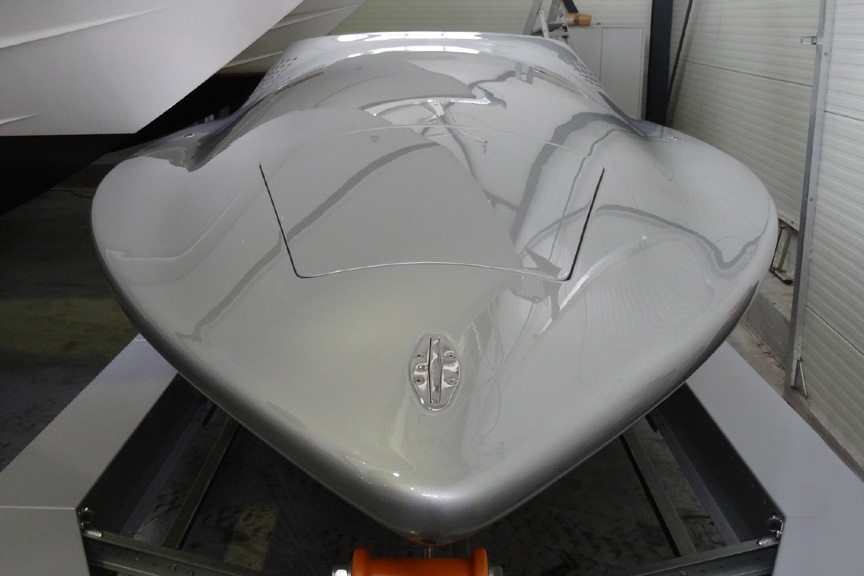
The TNSW-built Kineo with light gray pinstripe seats found its way to a warehouse in Drachten, The Netherlands and was then bought by Wilfred Rottier in 2012. Mr. Rottier had the Kineo put into new condition with no money spared.

Although Horst Stross spent his assets on chasing the dream, thanks to him Porsche Design has something really beautiful in its portfolio. How many 27-foot Kineos were exactly made, remains an open question. The only thing sure is that you can count them with the fingers on two hands.
The last chapter in the story of the Kineo speed boats was the Kineo 33 that was developed in 1991 in Italy and shown at the Boot ’92 Düsseldorf boat show. The Kineo 33 followed the design lines of Porsche Design, but was designed in Italy. The Kineo 33 was a welded aluminium boat, so a very cool one. Only one was made and its last known location was in 2015 in Estonia.
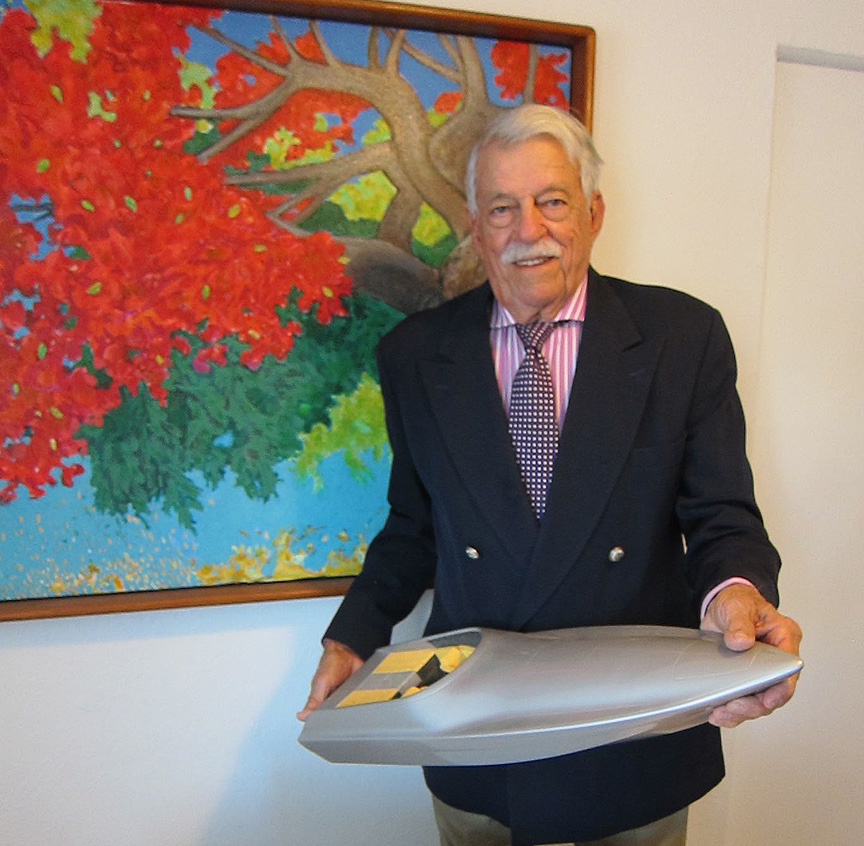
Thanks to: Dirk Schmauser, Jörg Tragatschnig, Christian Schwamkrug (studiofaporsche.com), Kiko Villalon (Ancon Marine Consultants Inc., Australian Safer Propellers Pty Ltd.), Gerald Berton (yacht.com.co), Frank M. Rinderknecht (rinspeeed.ch), Adam Erdberg (tempestyachts.net), Richard Mastry (mastry.com), Graham Stevens (powerboatarchive2.co.uk), Ryan J. Spano (nowboats.com)


